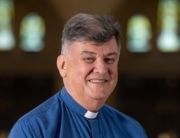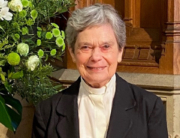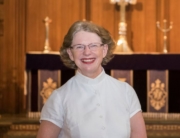A sermon given during the 6:00pm Choral Evensong, by The Rev’d Joan Claring-Bould, on the 12th March 2023.
I have never known a time in my Church life without a healing ministry. My first experience was at St Columba’s Church, Hawthorn where at evensong people were invited to be anointed for healing for themselves or someone else once a month.
Later I joined a world-wide healing ministry group, still active close by today, called the Order of St. Luke. For years our chapter of OSL met here at the Cathedral on a Thursday night, studying the scriptures, learning about the ministry of healing, and praying for any who had asked for our prayers and for each other and the ministry of our parishes.
Alongside that, for many years the Cathedral had its own healing service at the eucharist first on Saturdays at lunch time and then Tuesdays, before the ministry was transferred to offering anointing for healing to people after communion at the 10.30 eucharist.
Through the past 30 years a service including the ministry of healing has been kept active through the Taizé services which occur on the first Saturday night of each month at 7.30pm.
The clergy have always offered the ministry of unction, anointing with holy oil to individuals who are sick. This most often occurs when people are facing major surgery or coming to the end of their lives, but it is a ministry which is open to everyone seeking God’s help at a time of distress, so please feel free to speak to one of the clergy if you would like to receive that sacrament. I think we don’t speak about it enough.
It seems evident to me that in his ministry Jesus did two main things – he taught and he healed. It is my conviction about the centrality of the healing focus of the ministry of Jesus which has led to the healing ministry being central to my own ministry. Over the years I have been privileged to work with the leadership team from St Andrew’s Cathedral whose healing ministry is known over the world. I have also visited numerous healing centres in the UK and been privileged to work at Burrswood near Tunbridge Wells which was a unique combination of a NHS hospital and healing centre, combining medical and spiritual care.
And perhaps, more to my surprise, I learnt a lot about the ministry of healing from many months with the L’Arche Community in Toronto Canada. There I leant much from Fr. Henri Nouwen’s love, care, compassion and respect for each of the disabled core members of the community, but I learnt as much from the healing and forgiveness that the vulnerable core members so freely gave to those who had misunderstood them, rejected them, or been frightened of them. Their forgiveness was truly healing.
Turning our attention to the words of Jesus, in his mission statement from Luke chapter 4, amongst other things, Jesus says
“He has sent me to release the oppressed”. The same Greek word which is translated release or freedom here, is also one of the words used for forgiveness in the New Testament.
With that in mind, this statement of Jesus could then read “He has sent me to forgive the oppressed” This broadens the impact of forgiveness because it implies healing not for only for our sins, but for the effect of our sins on ourselves and those whom we may have damaged.
This brings us to tonight’s second reading. It’s a story from the gospel of St. Luke, St. Luke the physician – the man who was at pains to share with us the significance of the healing ministry of Jesus.
Here we are presented with a story of someone who has come in vulnerability to Jesus bringing a jar of very costly ointment, who weeps over his feet and dries them with her hair to the annoyance of the Pharisees, who indignantly proclaim that the money should have been given to the poor.
But the subplot is more important. The person baring the costly perfume is unacceptable in their presence. She is a sinner, she is a woman, she one of the oppressed and Jesus dares to let her touch him!
Then comes the punch lines. She was weeping over the burden of her sins which were many and had come to Jesus, prepared to risk everything, because she knew only he could set her free. It wasn’t the quantity or the nature of her sinning that was significant. It was the contrition of her heart and her faith in Jesus to forgive and set her free.
And she was healed. Forgiven, loved and free.
This tory reminds me of one of my favourite hymns, Drop Drop Slow Tears, the final verse of which reads:
“In your deep floods, drown all my faults and fears,
Nor let his eyes see sin, but through my tears.”
Within a ministry of healing people come seeking healing for all manner of things, many having nothing to do with sin! But that raises the question, what do we expect to happen when we pray ask for prayer for healing, or to be anointed for healing?
For me, the answer is I never know. I always hope and pray for the outcome that the person before me is longing for, but my primary focus is always praying that the person before me, and those for whom we are praying will be have the courage to let go of anything which is stopping them from opening their hearts in faith to the healing Love of God. The peace and joy which comes from spiritual healing often facilitates physical healing, or at least gives people renewed strength and hope to meet the challenges that lie ahead.
Some of you may have seen the film “The Mission”. “The story focusses on the lives of a slave trader called Roderigo Mendoza and Fr. Gabriel who witnesses amongst (first nations people) and colonists alike. Mendoza kills his younger brother in an angry dual because his brother wins the love of his own mistress. Yet afterwards he is full of remorse and pain, and is totally unable to find relief or peace of mind. Consequently, his state of unforgiveness drags him down into drunkenness and despair.
It is Fr. Gabriel who tells him of the forgiveness and salvation that await him if he turns to God. However, for Mendoza it all seems too easy and consequently too far from his grasp.
Then comes the moment of insight by which he sees he may receive the gift of forgiveness.
Fr. Gabriel is about to return to work amongst the (first nations people) in the mountains, and Mendoza insists on joining them. There follows the remarkable scene of Mendoza scaling the cliffs, but behind him he drags a huge (amount of) baggage consisting of all the weapons of his former occupation of slave trader. He is doing penance in a highly symbolic fashion, and like Christian in Bunyan’s Pilgrim’s Progress, he carries his burden until the moment of release… (He knows he can be forgiven by the act of God’s free grace).
The full impact or ability to receive (this) is still to come. Eventually Mendoza reaches the top of the mountain and lies dirty and exhausted on the ground but still he has no relief for the guilt. The Indians instantly recognise the man whom they hate and fear. One of them rushes over to the prostrate figure, takes out his knife and lifts Mendoza’s head.
Mendoza’s simply accepts the situation and awaits death. Suddenly the knife comes down and the huge baggage is released and falls off the clifftop.
Immediately the slave-trader is no longer the slave. He realises that the Indians have forgiven him and his many murders, and so he breaks down with relief into tears and laughter.”
This wonderful story of forgiveness reminds us that forgiveness, healing and reconciliation are not about obliteration of painful situations of the past, but rather about transformation of painful memories. It is a common experience that forgiveness with its associated healing, and reconciliation opens us to the possibility of a new grace-filled life beyond our imagination.



